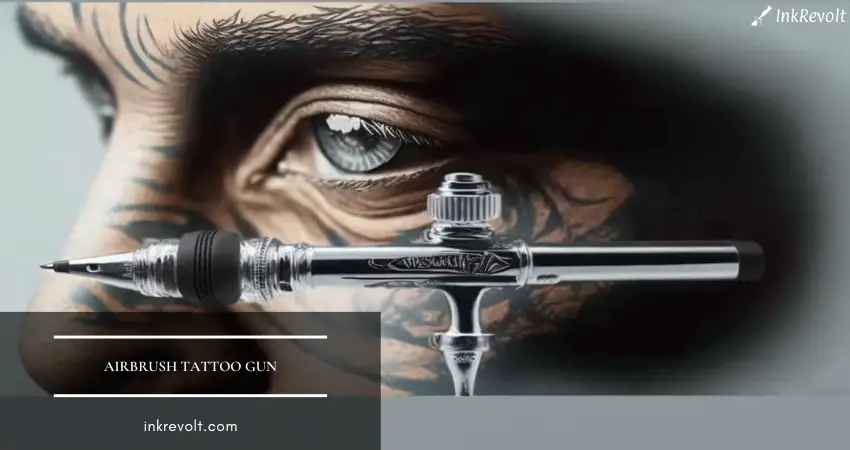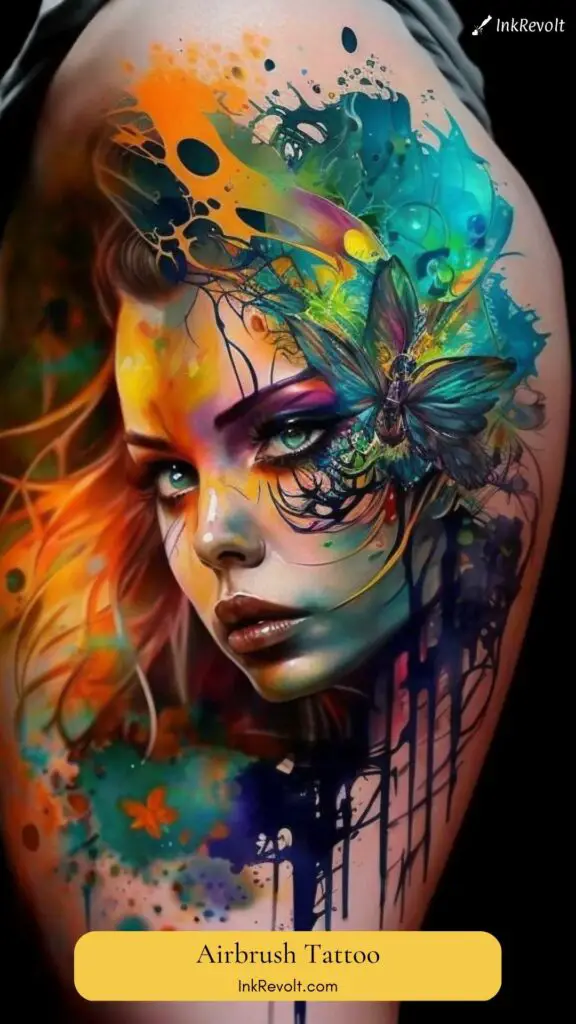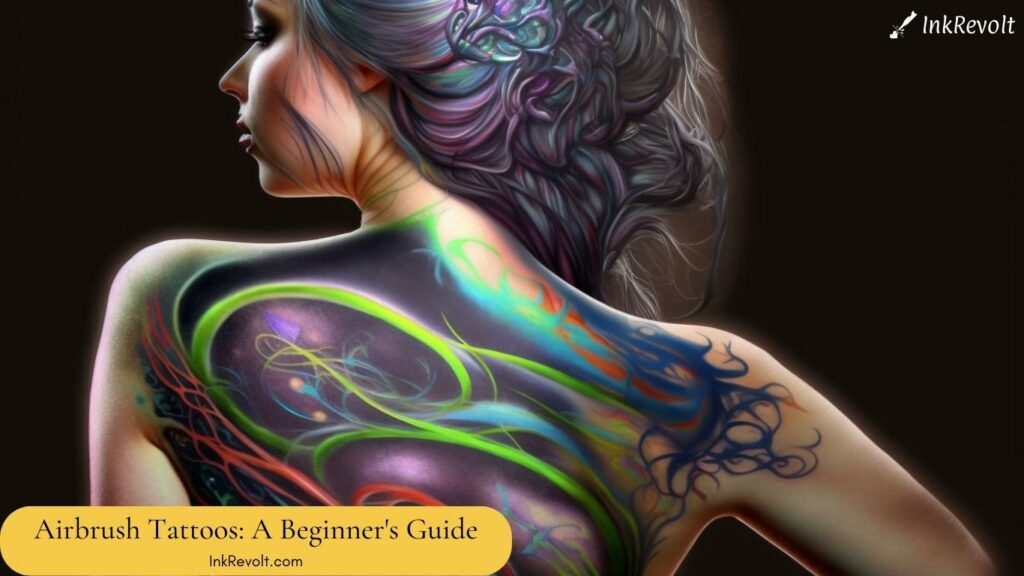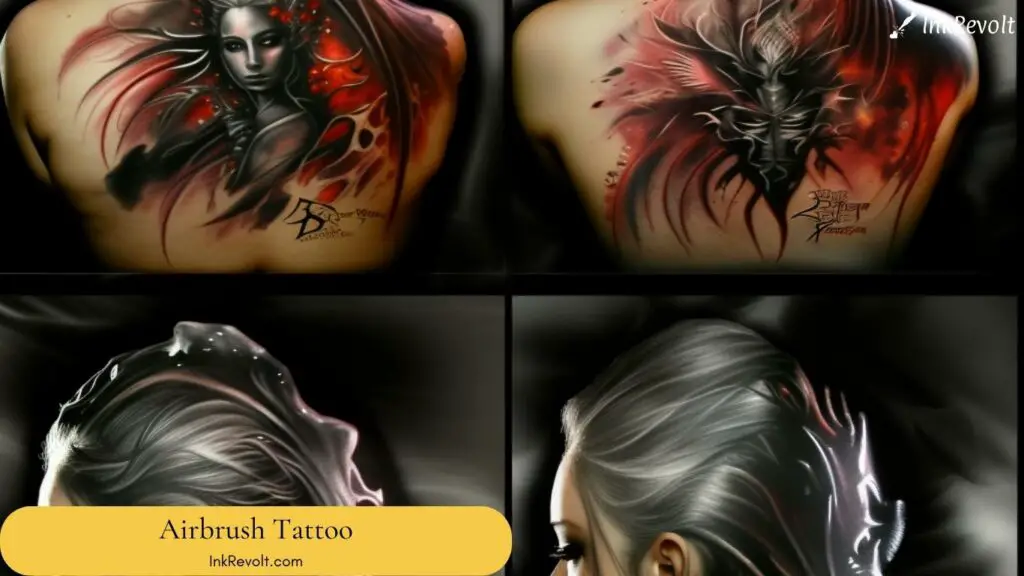Airbrush Tattoos: A Beginner’s Guide To Temporary Tattoos
If you’re looking for a way to experiment with tattoo art without the commitment of a traditional tattoo, airbrush tattoos might be the perfect option for you. Airbrush tattoos are temporary tattoos that are applied using an airbrush gun that sprays ink or paint onto the skin.
In this beginner’s guide, we’ll explore what airbrush tattoos are, the equipment you need to apply them, and the advantages and disadvantages of this unique form of tattoo art.
What are Airbrush Tattoos?
Airbrush tattoos are temporary tattoos that are applied using an airbrush gun, which sprays ink or paint onto the skin. Unlike traditional tattoos, airbrush tattoos are not permanent and can last for a few days to a few weeks, depending on the ink or paint used and how well the tattoo is cared for.
One of the primary differences between airbrush tattoos and traditional tattoos is the application process. Traditional tattoos are applied using a needle that punctures the skin to inject ink beneath the surface. In contrast, airbrush tattoos are applied using an airbrush gun, which sprays ink or paint onto the skin. This makes airbrush tattoos less painful than traditional tattoos, making them a great option for those who are sensitive to pain.

Another advantage of airbrush tattoos is the ability to create intricate and detailed designs with the use of stencils and transfer paper. These designs can be customized to suit individual preferences, and temporary airbrush tattoos offer a great opportunity to experiment with new designs and placements without a long-term commitment.
However, one of the disadvantages of airbrush tattoos is that they are not as long-lasting as traditional tattoos. They may also not be suitable for all skin types, as some individuals may be allergic to the inks or paints used.
Equipment Needed for Airbrush Tattoos
To apply airbrush tattoos, you will need specific equipment. Here are the primary pieces of equipment you’ll need:
1. Airbrush guns and compressors
Airbrush guns and compressors are the primary equipment needed to apply airbrush tattoos. There are two types of airbrush guns:
- Single-action
- Double-action
Single-action guns are easier to use and more affordable, while double-action guns provide more control and precision.
Piston and diaphragm compressors are the two types of compressors available, with diaphragm compressors being more suitable for airbrush tattoos.

2. Stencils and transfer paper
Stencils and transfer paper are used to create the designs for airbrush tattoos. Pre-made stencils can be used to create basic designs, while custom stencils are used to create intricate and unique designs.
Transfer paper is used to create freehand designs and is ideal for experienced airbrush tattoo artists.
3. Airbrush Tattoo Paints and inks
Water-based and alcohol-based inks and paints are used to apply airbrush tattoos. Water-based inks are less expensive and easier to clean up, while alcohol-based inks are more durable and provide better coverage.
Some of the popular brands of airbrush tattoo inks include EBA, Graftobian, and Temptu.
4. Cleaning supplies and equipment
To maintain the airbrush guns and compressors, cleaning supplies such as brushes and swabs, airbrush cleaner, and ultrasonic cleaners are used. These supplies ensure that the equipment is clean and functioning optimally for the next use.
Preparing for an Airbrush Tattoo
Before applying an airbrush tattoo, it’s important to prepare the skin and workspace properly. Here are the steps involved in preparing for an airbrush tattoo:
Step 1: Skin preparation and hygiene
Preparing the skin is an essential step to ensure that the airbrush tattoo adheres well and lasts for as long as possible. Follow these steps for skin preparation and hygiene:
Choose a Clean and Dry Area of Skin:
Choose a clean and dry area of skin where you want to apply the tattoo. Ensure that the area is free from oil, lotion, or other substances that can interfere with the adhesion of the tattoo.
Cleansing the Skin with Alcohol or Antiseptic Solution:
Use a gentle cleanser to clean the area and then follow up with an alcohol or antiseptic solution to remove any bacteria or other contaminants on the skin. This step is essential to reduce the risk of infection.
Step 2: Choosing a design and stencil
Choosing the right design and stencil is essential for a successful airbrush tattoo application. Follow these steps to choose a design and stencil:
Finding Inspiration for Designs:
Find inspiration for your airbrush tattoo design by browsing online, in magazines, or by consulting with the artist. Look for designs that reflect your personal style and that will look good on the chosen area of the skin.
Deciding on Placement and Size of the Tattoo:
Decide on the placement and size of the tattoo before applying the stencil. This will help ensure that the design is proportional and fits well on the area of the skin you have chosen.

Applying the Stencil to the Skin:
Once you have decided on the design and placement, apply the stencil to the skin. The stencil ensures that the airbrush tattoo is precise and looks professional. You can use a pre-made stencil or a custom one that you have created.
Additional Read: Best Tattoo Stencil Machines
Step 3: Setting up equipment and workspace
Setting up the airbrush tattoo equipment and workspace is crucial for the success of the application. Follow these steps to ensure a smooth process:
Ensuring the Airbrush Gun and Compressor are in Good Working Order:
Check the airbrush gun and compressor to ensure they are working correctly. Any malfunction or damage to the equipment can lead to subpar results and increased risks.
Preparing the Inks and Paints:
Prepare the inks or paints that you will use for the airbrush tattoo. Ensure that they are the correct type for the skin type, and mix them as per the manufacturer’s instructions.
Creating a Clean and Organized Workspace
Create a clean and organized workspace that is free from any distractions or contaminants. This ensures that you can concentrate on the application and that the equipment and supplies are safe from any contaminants.
Step 4: Safety precautions and considerations
There are several safety precautions and considerations to keep in mind before applying an airbrush tattoo. Follow these steps to ensure safety:
Wearing Gloves and Masks:
Wear gloves and masks during the application process to avoid any exposure to fumes or the ink/paint. This will help reduce the risk of any allergic reactions.
Using Ventilation or a Respirator:
Ensure that the workspace has proper ventilation or use a respirator to avoid inhaling any fumes.
Being Aware of the Risks of Infection or Allergic Reaction:
Be aware of the risks of infection or allergic reaction that may arise during the application process. If you have any allergies or skin sensitivities, it’s best to avoid airbrush tattoos.
Applying an Airbrush Tattoo
Once you have prepared the skin and workspace, it’s time to apply the airbrush tattoo. Here are the steps involved:
Applying The Tattoo
- Load the airbrush gun with the ink or paint of your choice and adjust the air pressure to the desired level.
- Hold the airbrush gun about 4-6 inches away from the skin and start applying the ink or paint in thin, even layers.
- Use short bursts of air to control the flow of ink or paint, and build up the color and shading as needed.
Removing the stencil and cleaning up any mistakes
Be sure to clean the airbrush gun between colors or when changing inks or paints to prevent clogging. Once the tattoo is complete, remove the stencil and clean up any mistakes or smudges using a clean brush or swab. If needed, touch up the tattoo with additional ink or paint to achieve a more precise design.
Tips and tricks for achieving a clean and precise design
To achieve a clean and precise design, use the right air pressure and distance from the skin. Mix inks and paints to achieve custom colors, and blend colors for a more realistic look.

Common mistakes and how to avoid them
To avoid over-spraying or under-spraying, practice spraying on a piece of paper or fabric before applying the tattoo. Clean the airbrush gun properly after each use and ensure that you are using the right type of ink or paint for the job.
Caring for an Airbrush Tattoo
To maintain the longevity of an airbrush tattoo, it’s important to take care of it properly. Here are the steps involved in caring for an airbrush tattoo:
Aftercare instructions for maintaining the longevity of the tattoo
Keep the tattoo dry and clean for the first few hours after application. Avoid rubbing or scratching the tattoo, and apply lotion or moisturizer to the tattoo to prevent cracking or peeling.
How to Remove an Airbrush Tattoo
If you want to remove an airbrush tattoo, you can use rubbing alcohol or baby oil. Follow these steps to remove the tattoo:
- Apply rubbing alcohol or baby oil to the tattoo. Use a cotton ball or cloth to gently rub the area.
- Continue rubbing until the tattoo begins to fade or comes off entirely.
- If the tattoo does not come off entirely, repeat the process until it does.
- Once the tattoo is removed, clean the area with soap and water.
- Apply moisturizer or lotion to the area to help soothe the skin.
How to Touch up an Airbrush Tattoo
If you want to touch up an airbrush tattoo, you can use more ink or paint to add color or fill in any areas that have faded. Follow these steps to touch up the tattoo:
- Choose the same color of ink or paint that was used for the original tattoo.
- Apply the ink or paint to the area that needs to be touched up.
- Use a small brush or sponge to blend the color in with the surrounding area.
- Allow the tattoo to dry completely before touching it or applying additional color.
- Apply a sealant or fixative to help the color last longer.

Risks and Considerations Associated with Airbrush Tattoos
It’s important to be aware of the risks and considerations associated with airbrush tattoos before getting one. Here are some of the primary risks and considerations:
Risk of Allergic Reactions
One of the biggest risks associated with airbrush tattoos is the possibility of an allergic reaction to the ink or paint used. Allergies can develop from any component used in the process, including inks, adhesives, or cleaners. Individuals with sensitive skin or a history of allergic reactions should avoid airbrush tattoos.
Risk of Infection
Infections can occur if the equipment or the skin is not properly cleaned and sterilized before the application of the tattoo. Additionally, cross-contamination can occur if the same ink or paint is used on multiple individuals.
Limited durability of the tattoo
Airbrush tattoos are not permanent and may last for a few days to a few weeks, depending on the ink or paint used and how well the tattoo is cared for.
Where to Get Airbrush Tattoos
There are several options for getting airbrush tattoos, including professional artists and studios, DIY kits, and local events and festivals. Here are some of the primary options:
1. Professional Airbrush Tattoo Artists and Studios
If you want a high-quality airbrush tattoo that looks professional and lasts for several weeks, you should consider visiting a professional artist or studio. Many professional tattoo artists now offer airbrush tattoos as a service, and there are also dedicated airbrush tattoo studios that specialize in this temporary art form.

Choosing a Reputable Artist or Studio
When choosing a professional artist or studio, you should take the time to research and check their portfolio and reviews. Look for an artist who has experience in airbrush tattoos and can provide examples of their work. Additionally, ensure that the artist or studio follows proper hygiene and sterilization procedures to avoid the risk of infection.
Cost and Availability
The cost of airbrush tattoos can vary depending on the artist or studio and the complexity of the design. In general, prices start from around $20 for a simple design and can go up to $100 or more for more intricate designs. Availability may also depend on the location and season, so it’s always best to book an appointment in advance.
2. DIY Airbrush Tattoo Kits
If you’re looking to create your own airbrush tattoos at home, there are several DIY airbrush tattoo kits available on the market. These kits come with everything you need to create temporary tattoos, including an airbrush gun, compressor, inks or paints, and stencils.
Choosing the Right Kit
When choosing a DIY airbrush tattoo kit, it’s essential to consider your skill level and the type of design you want to create. Some kits may be more suited for beginners, while others may be more advanced. Additionally, ensure that the kit comes with proper instructions and safety precautions.
Following Safety Precautions and Instructions
It’s important to follow proper safety precautions and instructions when using a DIY airbrush tattoo kit. Wear gloves and a mask to avoid inhaling any fumes, and ensure that the area is well-ventilated. Additionally, always clean and sterilize the equipment before and after use.
3. Local Events and Festivals
Airbrush tattoos are often available at local events and festivals, such as fairs, carnivals, and concerts. This can be a fun way to get a temporary tattoo while enjoying the atmosphere of the event.
Finding Local Events and Festivals
To find local events and festivals that offer airbrush tattoos, you can check online listings, social media platforms, and community bulletin boards. Be sure to research the quality and safety of the artists and equipment before getting a tattoo.
Frequently Asked Questions
Here are some common questions and answers about airbrush tattoos:
Are airbrush tattoos painful?
Airbrush tattoos are less painful than traditional tattoos since they are not applied using a needle. However, some individuals may experience slight discomfort or a burning sensation during the application of the tattoo.
How long do airbrush tattoos last?
The longevity of airbrush tattoos depends on various factors such as the quality of the ink or paint, the area where the tattoo is applied, and the level of aftercare. In general, airbrush tattoos can last for a few days to a few weeks.
Can airbrush tattoos cause allergic reactions?
Yes, airbrush tattoos can cause allergic reactions if an individual is sensitive to the ink or paint used. It’s important to check the list of ingredients used in the ink or paint and ensure that none of them are allergens for you.
How can I remove an airbrush tattoo?
Airbrush tattoos can be removed using rubbing alcohol or baby oil. Apply the substance to the tattoo and rub gently with a cotton ball or cloth.
Are airbrush tattoos safe?
Airbrush tattoos are generally safe if the equipment and the artist follow proper hygiene and sterilization procedures. However, there is a risk of infection or allergic reaction if the equipment or the skin is not properly cleaned and sterilized.
Can I swim or take a shower with an airbrush tattoo?
It’s best to avoid swimming or taking a shower for at least a few hours after getting an airbrush tattoo. Water can cause the tattoo to fade or wash off. Additionally, avoid rubbing or scratching the tattoo while it’s wet.
Can I get a custom design for an airbrush tattoo?
Yes, you can get a custom design for an airbrush tattoo. You can create your own stencil or work with a professional artist to create a unique design that reflects your personal style.
Can I apply an airbrush tattoo on any part of my body?
Airbrush tattoos can be applied on any part of the body, but some areas may be more sensitive or prone to irritation than others. It’s important to choose a clean and dry area of skin and avoid applying the tattoo on broken or irritated skin.
Wrapping Up
Airbrush tattoos offer a unique way to experiment with tattoo art without the commitment of traditional tattoos. By using specific equipment such as airbrush guns, stencils, and inks or paints, you can create intricate and detailed designs on your skin. However, it’s important to be aware of the advantages and disadvantages of airbrush tattoos before getting one.
By following the steps involved in preparing for and applying an airbrush tattoo and using the right tips and tricks, you can achieve a clean and precise design that expresses your unique style. Remember to take safety precautions and be aware of the risks associated with airbrush tattoos.
With the right equipment and mindset, you can create temporary tattoos that will turn heads and leave a lasting impression.
